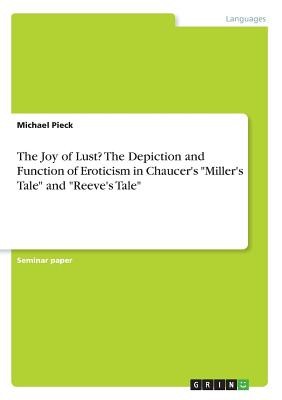
- We will send in 10–14 business days.
- Author: Michael Pieck
- Publisher: GRIN Verlag
- ISBN-10: 3668313644
- ISBN-13: 9783668313644
- Format: 14.8 x 21 x 0.2 cm, softcover
- Language: English
- SAVE -10% with code: EXTRA
The Joy of Lust? The Depiction and Function of Eroticism in Chaucer's Miller's Tale and Reeve's Tale (e-book) (used book) | bookbook.eu
Reviews
Description
Seminar paper from the year 2010 in the subject Didactics - English - Literature, Works, grade: 1,3, University of Cologne (Englisches Seminar), course: Hauptseminar "English Literature from Chaucer to Shakespeare", language: English, abstract: This paper will scrutinize the "Miller's Tale" and the "Reeve's Tale" with regard to their erotic contents and the instances of obscene speech. The main emphasis will be put on a discussion on the genre of the tales as well as the question, whether instances of eroticism are really the light-hearted expression of joyful lust, or rather skillful narrative means serving both the authentic representation of the characters and the emphasizing of the tales' overall morals. There is hardly any period in history that has preoccupied people of later eras as much as the Middle Ages. They have been a recurring popular subject in literature over the last two hundred years. The film industry could not go without them. One reason for this fascination might be the fact that the Middle Ages are both a part of our own history, still visible in magnificent church buildings, and an era that lies half a millennium away from us. This distance and a rather limited knowledge about the 'real' circumstances contribute to a hazy image leaving plenty of space for interpretation and imagination. A popular view on the Middle Ages from our perspective is that of jaunty folk, who enjoyed their lives being free of the restraints of our modern society. It is therefore not surprising that the Italian director Pier Paolo Pasolini chose the "Canterbury Tales" for one of the films in his Trilogy of Life the other two being Bocaccio's "The Decameron and Arabian Nights". Pasolini made his films in a time which today is referred to as the 'Sexual Revolution'. Perhaps it was the undisguised depiction of sexuality in some of the "Canterbury Tales" which had inspired him to adapt them for the screen. One of the "Canterbury Tales" we find in Pasolini's film is the
EXTRA 10 % discount with code: EXTRA
The promotion ends in 11d.04:15:52
The discount code is valid when purchasing from 10 €. Discounts do not stack.
- Author: Michael Pieck
- Publisher: GRIN Verlag
- ISBN-10: 3668313644
- ISBN-13: 9783668313644
- Format: 14.8 x 21 x 0.2 cm, softcover
- Language: English English
Seminar paper from the year 2010 in the subject Didactics - English - Literature, Works, grade: 1,3, University of Cologne (Englisches Seminar), course: Hauptseminar "English Literature from Chaucer to Shakespeare", language: English, abstract: This paper will scrutinize the "Miller's Tale" and the "Reeve's Tale" with regard to their erotic contents and the instances of obscene speech. The main emphasis will be put on a discussion on the genre of the tales as well as the question, whether instances of eroticism are really the light-hearted expression of joyful lust, or rather skillful narrative means serving both the authentic representation of the characters and the emphasizing of the tales' overall morals. There is hardly any period in history that has preoccupied people of later eras as much as the Middle Ages. They have been a recurring popular subject in literature over the last two hundred years. The film industry could not go without them. One reason for this fascination might be the fact that the Middle Ages are both a part of our own history, still visible in magnificent church buildings, and an era that lies half a millennium away from us. This distance and a rather limited knowledge about the 'real' circumstances contribute to a hazy image leaving plenty of space for interpretation and imagination. A popular view on the Middle Ages from our perspective is that of jaunty folk, who enjoyed their lives being free of the restraints of our modern society. It is therefore not surprising that the Italian director Pier Paolo Pasolini chose the "Canterbury Tales" for one of the films in his Trilogy of Life the other two being Bocaccio's "The Decameron and Arabian Nights". Pasolini made his films in a time which today is referred to as the 'Sexual Revolution'. Perhaps it was the undisguised depiction of sexuality in some of the "Canterbury Tales" which had inspired him to adapt them for the screen. One of the "Canterbury Tales" we find in Pasolini's film is the


Reviews